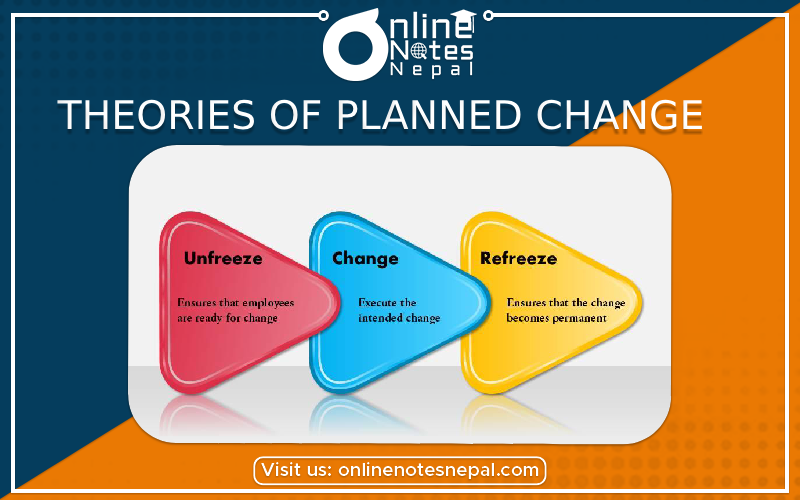Published by: Dikshya
Published date: 28 Jul 2023

Introduction:
Theories of planned change provide frameworks and models that guide organizations and individuals in implementing intentional and purposeful changes. These theories emphasize the importance of proactive planning, structured approaches, and systematic steps to facilitate successful transitions. Here, we will explore some prominent theories of planned change and their key components.
1. Lewin's Three-Step Model: Proposed by Kurt Lewin in the 1940s, this classic model is one of the earliest and most influential theories of planned change. It consists of three stages:
a. Unfreezing: This stage involves preparing individuals and the organization for change by breaking down existing patterns and beliefs. It aims to create awareness of the need for change and reduce resistance.
b. Moving: The second stage focuses on implementing the actual change. It involves introducing new ideas, processes, or structures and facilitating their integration into the organization or individual's behavior.
c. Refreezing: In this final stage, the changes are solidified and stabilized to become the new status quo. The goal is to ensure that the new behaviors or processes become a permanent part of the organization or individual's routine.
2. Kotter's Eight-Step Model: Developed by John P. Kotter, this model provides a comprehensive approach to managing change in organizations. It emphasizes the importance of establishing a sense of urgency, forming a guiding coalition, and communicating the vision for change. The eight steps are:
a. Create a Sense of Urgency: Convey the need for change and the risks of maintaining the status quo.
b. Form a Guiding Coalition: Assemble a group of influential individuals who will lead and support the change effort.
c. Create a Vision for Change: Develop a clear and compelling vision that outlines the desired future state.
d. Communicate the Vision: Share the vision with all stakeholders to gain their commitment and support.
e. Empower Action: Remove obstacles and empower employees to act on the vision.
f. Generate Short-Term Wins: Celebrate quick wins to build momentum and demonstrate progress.
g. Consolidate Gains: Use early successes to propel further change initiatives.
h. Anchor the Change: Embed the new behaviors and practices into the organization's culture to ensure sustainability.
3. Prochaska and DiClemente's Stages of Change Model: This model, initially developed for individuals' behavioral changes, can also be applied to organizational change. It identifies five stages:
a. Precontemplation: The individual or organization is unaware of the need for change or has no intention of changing.
b. Contemplation: Awareness of the need for change arises, and the pros and cons of making the change are weighed.
c. Preparation: The decision to change is made, and plans are developed for implementing the change.
d. Action: The change is put into effect, and the new behaviors or processes are adopted.
e. Maintenance: The change becomes a permanent part of the individual or organization, and efforts are made to prevent relapse into old habits.
Conclusion:
Theories of planned change provide valuable insights and frameworks for effectively managing change at individual and organizational levels. Whether it's Lewin's Three-Step Model, Kotter's Eight-Step Model, or Prochaska and DiClemente's Stages of Change Model, understanding these theories can assist in creating a structured and purposeful approach to navigate through the complexities of change, anticipate potential challenges, and increase the likelihood of successful change implementation.